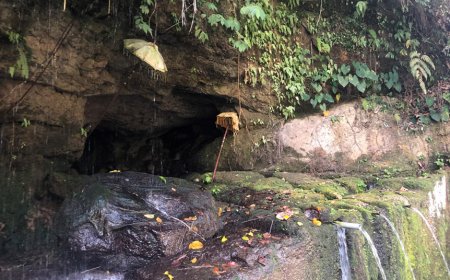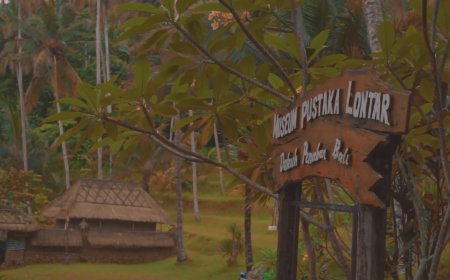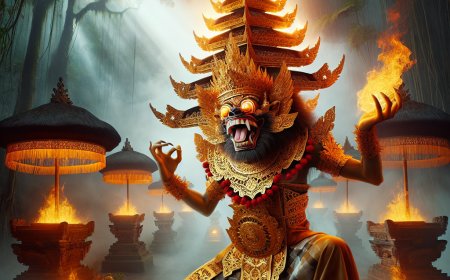Tracing the Historical Heritage in the Kertha Gosa Klungkung Hall of Justice
The Kertha Gosa Klungkung Hall of Justice in Bali, Indonesia, is a historical heritage that combines a rich culture and art. This article will take readers on a short, fascinating journey, inviting them to explore the beauty of the art, the impressive ceiling frescoes, and the important history of this hall of justice in Balinese culture. In a few words, readers will feel the charm of the heritage hidden within this magnificent building.

Indonesia is a country rich in cultural and historical heritage. The history of this nation has undergone a long journey, from prehistoric times to the colonial era, and finally to the Reformation era. This journey process not only produces historical stories, but also produces many valuable relics, one of which is an architectural masterpiece.
Historical architecture in Indonesia has many distinctive characteristics that reflect the times and cultural diversity of the region. This architectural facade from the past has a very strong attraction. This was especially seen during the Kingdom era in Indonesia. Architectural works from the Kingdom period are not only witnesses of history, but also have high artistic value.
The importance of preserving these architectural works can be seen from several things. First, architectural works from the Kingdom period have their own uniqueness if they can be preserved to this day. When this traditional architectural heritage is preserved, the elements of the city will become even more enchanting and beautiful. Many foreign tourists from various countries come to Indonesia to experience, understand and appreciate various aspects of its culture, knowledge and history.
One of the islands in Indonesia that is famous internationally, even for local tourists, is Bali. This island has succeeded in capturing the hearts of many tourists from all over the world with the charm of its rich culture, art and history.
The island of Bali, which is often referred to as heaven on earth, has a unique attraction, especially for lovers of traditional art. Apart from offering a variety of natural beauty, art and culture in its various regions, Bali also has historical areas which have architectural heritage with strong aesthetic, historical and symbolic values, all of which are still rooted in a rich culture. One example is the Balinese Klungkung Royal Architecture, also known as Puri Klungkung, which is one of the centers of power in Bali. It was part of the Bali Kingdom, which included Gelgel, and reached its peak in government, customs, arts and culture.
The existence of Klungkung Royal Architecture has significant historical value as a cultural heritage that needs to be preserved. Currently, the former palace building has been revitalized and is used as a government building, school, museum, and so on. Several historical buildings such as Taman Gili, Gelung Kori, and Kertha Gosa still stand as relics of the past, even though they experienced major wars or the dramatic Klungkung incident.
The beauty and characteristics of traditional architecture in Kertha Gosa and the like are still maintained today, and conservation efforts for these buildings are a solution to increase aesthetic value, cultural value and historical value as part of the assets of the Indonesian nation. This is not only for public interest, but also as a source of knowledge, insight, and even inspiration for practitioners of art, architecture, interiors, historians, and those who wish to visit the place.
Unfortunately, many historical relics and architecture have been lost due to the impact of age and lack of awareness among the public and authorities in preserving and maintaining their authenticity. Therefore, the importance of conservation and preservation efforts for this heritage cannot be underestimated. Historical areas or buildings like this can be used as places for various types of conservation activities that can provide benefits in various aspects, including education, social, economic, cultural, tourism, and many more.
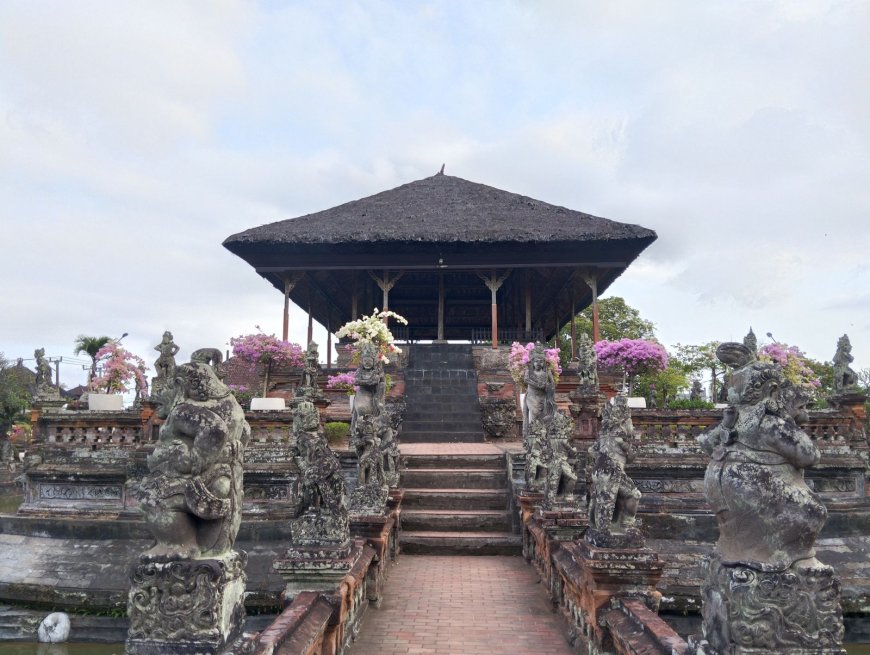
Bale Kambang Front View (Source: Private collection)
The Klungkung kingdom was considered the highest and most important kingdom of the nine kingdoms in Bali from the end of the 17th century to 1908. This kingdom was the heir to the old Gelgel kingdom, which had dominated the island for a long time but then broke up at the end of the 17th century. 17th century. In 1686 (or, in another version, 1710), I Dewa Agung Jambe, a prince descended from the old Rajas Gelgel, moved to Klungkung (also known as Semarapura) and built a new palace or puri. Although it did not have the prerogatives of its Gelgel ancestors, the new palace retained its prestige and authority on the politically fragmented island. This palace was built in a square shape, measuring approximately 150 meters on each side with the main gate in the north. It is divided into blocks with various ritual and practical functions. The complex displays deep symbolism according to a fixed structural pattern.
Kertha Gosa Klungkung is one of the historical sites that is very important to preserve on the island of Bali. Its typical Balinese architectural design and carvings depicting history make it a suitable place for a holiday while studying history. It is not surprising that this place is often visited by tourists who want to enjoy its uniqueness and charm. Kertha Gosa is also a clear example of Balinese architecture that is strong with traditional elements. Consists of two buildings, namely Bale Kertagosa and Bale Kambang. One of the most interesting things about Kertha Gosa is the Bale ceiling which is decorated with wayang paintings. These paintings depict the cases that were tried and the punishments meted out for the offenses.
Kerta Gosa is part of the heritage building and court complex of the Semarapura Palace, which stood from 1686 to 1908 and continued to function during the Dutch colonial rule from 1908 to 1942. In this complex, we can find three important heritage objects from the Semarapura Palace, namely Bale Kerta Gosa, Bale Kambang with the Taman Gili pool, and the Palace Gate. On the west side of this complex, there is the Semarapura Museum building which follows a European architectural style, which was previously a former Dutch school.
Initially, Kertha Gosa Klungkung was used as a place for discussions about the welfare and prosperity of the people of Klungkung. The name "Kerta Gosa" itself comes from Sanskrit, consisting of two words, namely "Kerta" or "Kertha" which means good, noble, safe, peaceful, happy and prosperous, and "Gosa" which comes from the word "Gosita" which means called, announced, and broadcast. So, Kerta Gosa is a place where good things are announced or a place to achieve peace and prosperity. Kerta Gosa is also used as a place for the king to hold deliberations related to the peace and welfare of the kingdom, including matters of security and justice.
The Kertha Gosa Klungkung building was originally built in 1686 by the first leader, Ida I Dewa Agung Jambe, and was part of the Klungkung royal complex. However, during the Dutch colonial period, Kertha Gosa functioned as a place of justice. The Kerta Gosa building has been standing since 1700 AD, which we can know from the Çandra Çangkala year number displayed at the entrance to the complex. This year number corresponds to the reign of King Dewa Agung Jambe, who is said to have given the name "Kerta Gosa" to this building.
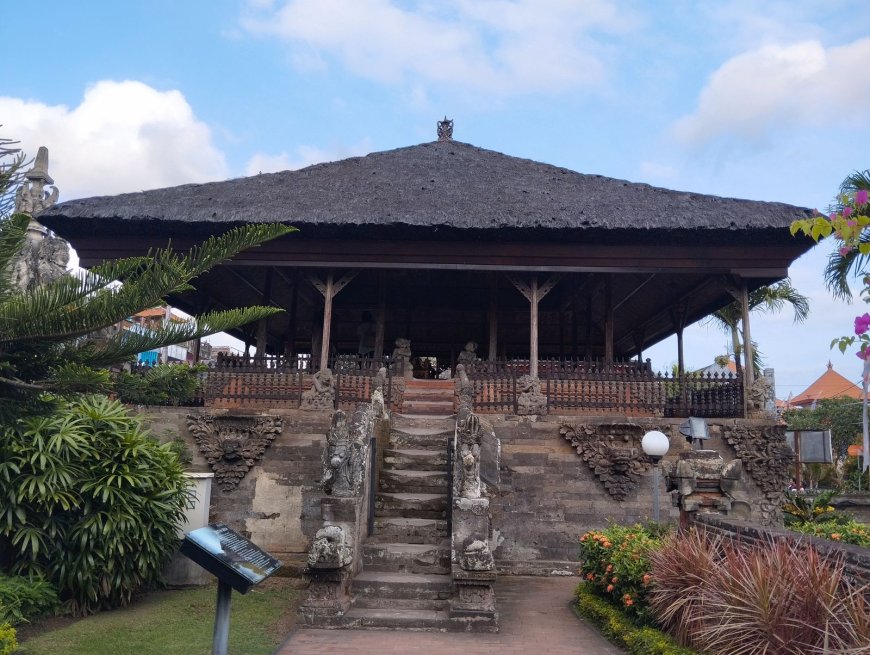
Kertha Gosa Pavilion or Court Hall (Source: Private collection)
Every month, on a special Wednesday known as "Buda Kliwon," the top officials of the Klungkung kingdom hold a meeting at Kertha Gosa. This meeting was attended by the king's aides, called "Manca," from Klungkung Regency. Apart from that, Kertha Gosa was also used as a place to receive the King's Priestess and Priestess (Bagawanta) for lunch, as well as to receive visits from foreigners who wanted to meet the King.
During the Balinese Kingdom, every year, at the "Purnamaning Kapat" celebration which occurred on the full moon of the fourth month of the Balinese calendar, a meeting was held at Kertha Gosa. This meeting was attended by kings from various regions in Bali, where the High King of Klungkung gave directions and decisions regarding issues relevant to the needs and situation in the Kingdom of Bali.
However, on April 28 1908, the Dutch army came to Klungkung to conquer the King of Klungkung. The king and his people put up fierce resistance to the Dutch army, and bloodshed was inevitable. The people of Klungkung and their king finally put up a final resistance, known as "Puputan," against the Dutch army. As a result, Klungkung finally fell into Dutch hands.
After that event, Kertha Gosa functioned as a court that handled customary issues and also took action against certain religious practices. The court is equipped with one table and six chairs. The chair with the lion symbol is intended for the King as chairman of the court, the chair with the cow symbol is for the priest as the lawyer and advisor to the King in decision making, and the chair with the dragon symbol is for the secretary. The people on trial sat cross-legged on the floor politely. Sometimes, "Controllers" (Dutch officers who controlled the territory) were also present in court at very special sessions.
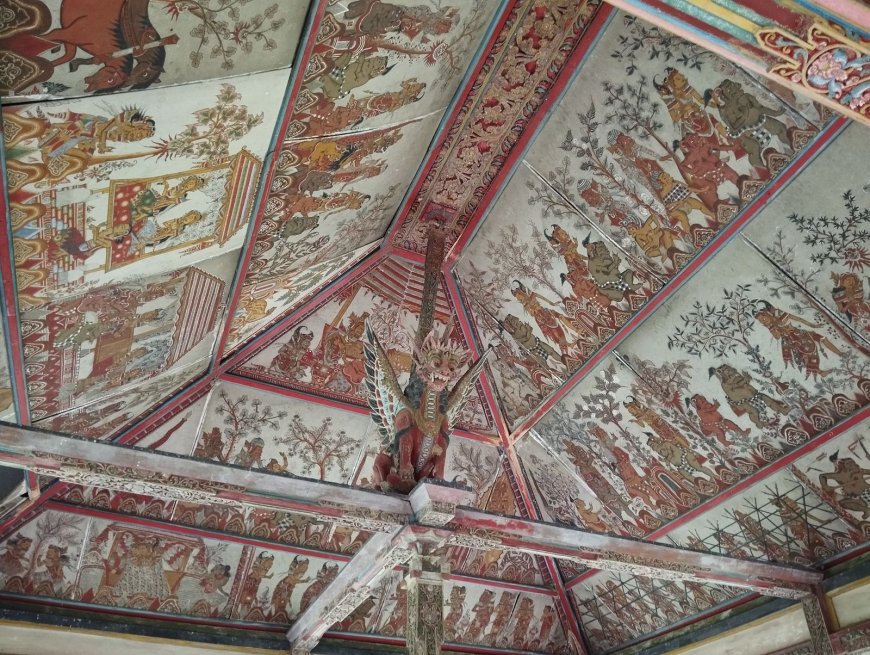
One of the Wayang Paintings in Kertha Gosa Klungkung (Source: Private collection)
Kertha Gosa has a series of paintings depicting various aspects of Balinese life and beliefs:
The first part, "TANTRI KANDAKA," explains various forms of cheating in society.
The second and third sections, "ATMA PRESANGSA," describe the punishment and suffering of the departed soul. The story of Bima Sena who searches for the spirits of his parents illustrates the concept of the law of karma.
The fourth section, "SANG GARUDA AMERTA," depicts the mythical bird Garuda in search of the water of eternal life, taken from Adiparwa.
The fifth section, "PELELINDON," deals with earthquakes and their ability to predict events in the world.
The sixth and seventh parts tell the story of Bima Sena's journey in his efforts to save his parents' lives from punishment.
The eighth section, "HEAVEN OF SPIRITS," describes a special place in heaven for souls who are faithful in carrying out religious teachings and doing many good deeds.
The ninth part tells the story of God who maintains balance in the world.
All these elements make Kertha Gosa an important historical site in Balinese culture, reflecting the history and values held dear by the Balinese people.
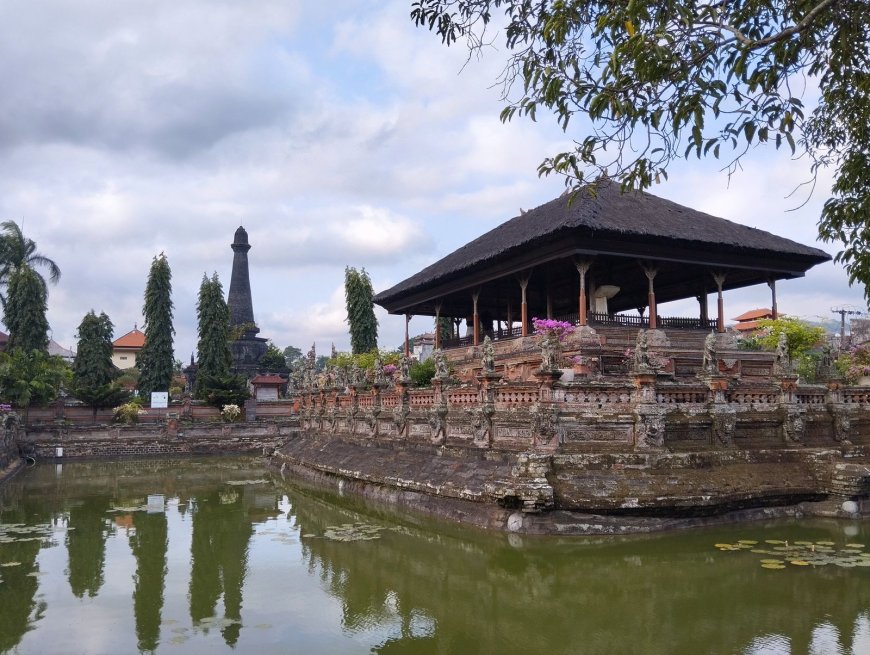
Gili Park or Bale Kambang Side View (Source: Private collection)
Gili Park is located on the left side of Kertha Gosa. “Gili” is a piece of land in the middle of the pond. Gili Park is a park in the middle of a pond. It is also known as Bale Kambang which means floating house and is as old as Kertha Gosa. The theme of the painting shows that this bale is used for traditional royal family ceremonies such as weddings and tooth-cutting ceremonies. The Kerta Gosa and Taman Gili buildings consist of a base and a roof. The base of the building is rectangular with two floors, where the first floor is wider than the second floor. The roof of the building is made of palm fiber, while the base is made of stone and brick with steps (steps up). The roof is decorated with statues and reliefs surrounding the building. The ceiling inside the building is decorated with traditional paintings in the Kamasan wayang style. These paintings tell stories such as Sutasoma, Pan Brayut, and Palalintangan in Taman Gili, as well as Ni Dyah Tantri, Biwa Swarga, Adi Parwa, and Pelelindon in Kerta Gosa. These stories include moral and ethical teachings in addition to traditional painting aesthetics.
Sutasoma tells the story of Sutasoma's journey, who faces various obstacles in achieving inner peace. Pan Brayut describes the life of a woman with 18 children and her limited time. Palalintangan is related to beliefs about the influence of the stars on human character. Ni Dyah Tantri tells about the wisdom of a princess in facing the king's wishes. Bima Swarga describes Bhima's journey to find his parents in the afterlife. Pelelindon describes 35 types of human character based on the influence of stars. The Kerta Gosa site has received conservation treatment from the community and government. In 1930, the wayang paintings in Kerta Gosa and Taman Gili were restored by painters from Kamasan, by replacing worn cloth and "parba" with new paintings that followed the original style. The last restoration was carried out in 1960. Kerta Gosa is recognized as an important cultural heritage.
Apart from that, wayang paintings also visualize the concept of the law of Karma Pahala, namely the good and bad consequences of human actions during their lives, as well as reincarnation to atone for these sins. The paintings on the ceiling of this bale are traditional Kamasan style works of art, originating from Kamasan village in Klungkung district. Usually, Kamasan's paintings use themes such as the Ramayana or Mahabarata in his work.


















































